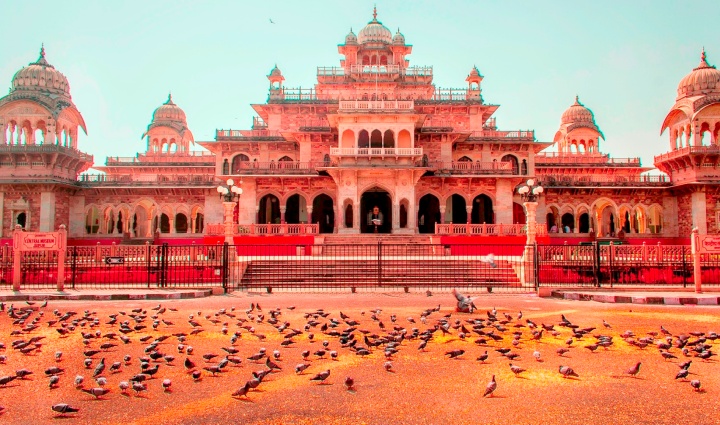City Palace Jaipur
Situated in the northeast of the beautiful city of Jaipur, the City Palace is a stunning complex of buildings, gardens, temples, pavilions, and courtyards which sprawls over a few acres of land. It was constructed within 1729 – 1732 by the Rajput King, Sawai JaiSingh II, the ruler of Amber. The outer walls of the building were planned and constructed by Jai Singh II while successive rulers made substantial addition to the building.

History
The present site of the palace, initially used to house a royal hunting villa surrounded by rugged hills about 8 kilometers south of the previous capital at Amber. In 1727, a rapid increase in population and a severe shortage of water prompted Sawai Jai Singh II to shift the capital to Jaipur. Following his death in 1744, most of the Rajput kings were busy fighting between themselves. However, they maintained a friendly relationship with the British Government and during the military uprising of 1857, Maharaja Ram Singh stood by the British Raj (Wikipedia
Article). It was he who painted the city pink in 1878 in order to welcome the Prince of Wales who visited the city. Maharaja Man Singh II, the last King of Jaipur, used to rule from this palace and a major portion of the building is still used as the residence of the royal family.
What to Expect
Like otherwhich? architectural marvels of the city, the palace is also a unique combination of Rajput and Mughal architecture. There are three very ornamental entrances to the Palace – the Virendra Pol, Udai Pol, and the Tripolia Gate which is reserved only for the royal family. Visitors can enter through the Udai Pol or the Virendra Pol or the stable gate known as Atish Pol. The entrance from Virendra Pol leads directly to the Mubarak Mahal or the Auspicious Palace which is a superb blend of Rajput, Mughal, and European architecture. Built by King Madho Singh II in the 19th century, it was used as a reception hall for guests. Now it has been turned into a museum displaying the royal costumes.
The most striking building within the palace compound is the Chandra Mahal which is a building of seven stories. Only the ground floor of the palace is accessible for the general public, since the descendants of the royal family onced used the palace as their residence. The museum on the ground floor displays a number of royal artifacts and other historical curiosities. The building sprawls over a vast stretch of land with nicely laid-out gardens and a beautiful lake in the front. The Pritam Niwas Chowk comprises of the inner courtyard with four gates which are beautifully carved, representing the four seasons of the year and images of Hindu Gods. The hall for the private audience known as the Diwan-I-Khas lies between the art gallery and the armory.
One can see two huge silver jars with a capacity of 4,000 liters which weighs nearly 340 kg. Made by melting 14,000 silver coins, it is the largest silver vessel of the world, according to the Guinness Book of World Records. The vessel was created for Sawai Madho Singh II, a devout Hindu who carried the water of Ganga to drink on his visit to England in 1901.
The hall of the public audience or the Diwan-I-Am is an attractive chamber and the ceilings are painted richly in gold and red which shines vibrantly, even to this day. Now used to display works of art, the chamber houses some of the most exquisite Persian, Mughal, and Rajput miniature paintings. The art gallery also displays rare handwritten manuscripts of Hindu Scriptures.
One can also see the golden throne where the King used to sit while attending his audience. The entrance to this hall has two huge elephants carved out of a single block of marble. The residence for the Queens or the Maharani Palace is also converted into a museum, which displays the weapons used by the royal family. Its ceiling contains a number of beautiful frescoes which are well preserved.
The Bhaggi Khana is yet another museum which houses an amazing collection of old carriages, cabs, and palanquins (Wikipedia Article).
The Govind Dev Ji temple, built in the 18th century and dedicated to Lord Vishnu (Wikipedia Article), is set in a beautiful garden. The ceiling of the temple is plated with gold and the prayer can be observed by the devotees 7 times a day.
The palace is open for all visitors every day of the week from 10AM – 5 PM.
How to get there
Located right in the heart of the Pink City, the visitor is sure to notice the imposing structure of the beautiful city palace. One of the most popular tourist destinations of India, Jaipur is well connected by flights and trains to all other major Indian cities.
Travelers flying from abroad must make a stopover at Delhi.

